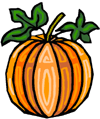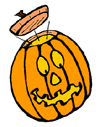
One of my most favorite things about Fall is Pumpkins. I love the look, the taste, the smell - it is one of the most incredible smells in nature!
Today...is all about pumpkins! I'll be posting some yummy recipe's later in the week!
Anatomy of a Pumpkin
Pumpkins have been examined, studied, and literally dissected more than any other object. Aside from frogs in Biology class, we can't think of any other item that has been more thoroughly examined in the classroom, or at home for that matter.
Young and old kids alike, constantly ask "what's this part" or "what's that part called?" Do you know the entire anatomy of a pumpkin? As a pumpkin expert, you will want to be certain of the answer when the question is posed.
Here is the complete pumpkin anatomy:
Stem- Located on the very top of the pumpkin. It is brown to brownish green, and slightly curved. During the growing season, the stem is attached to the vine. It is the umbilical cord, bringing nutrients to grow the fruit. For the Fall /Halloween season, the stem gives the pumpkin "Character". Be careful not to lift a pumpkin by its stem, as it can easily break off of the fruit.
 Tendril- Sometimes attached to the stem are thin, hairlike "tendrils" During the growing season, tendrils on the vine are green. They twist around objects on the ground to help anchor the vine and protect it from the wind. After harvesting, there are sometimes dried, brown tendrils on the stem. This gives the pumpkin character, and is viewed as artistic in pictures.
Tendril- Sometimes attached to the stem are thin, hairlike "tendrils" During the growing season, tendrils on the vine are green. They twist around objects on the ground to help anchor the vine and protect it from the wind. After harvesting, there are sometimes dried, brown tendrils on the stem. This gives the pumpkin character, and is viewed as artistic in pictures.
 Leaves- The leaves of a pumpkin absorb energy from the sun for plant and fruit growth. Jack O'Lanterns for carving do not have any leaves, just a short stem. Artist's rendering of fall pumpkins sometimes have a few green leaves sitting atop the fruit and attached to the stem. In reality, a the stem doesn't have leaves. The vine does(further away from the stem). Also, once removed from the plant, those green leaves would not remain fresh and green for long.
Leaves- The leaves of a pumpkin absorb energy from the sun for plant and fruit growth. Jack O'Lanterns for carving do not have any leaves, just a short stem. Artist's rendering of fall pumpkins sometimes have a few green leaves sitting atop the fruit and attached to the stem. In reality, a the stem doesn't have leaves. The vine does(further away from the stem). Also, once removed from the plant, those green leaves would not remain fresh and green for long.
 The Lid- Cut around the stem to open up the pumpkin prior to carving. This becomes the "lid".
The Lid- Cut around the stem to open up the pumpkin prior to carving. This becomes the "lid".
Pumpkin Shell- This refers to both the skin and the pulp of the fruit.
Skin- The thin, shiny, orange outer layer of a pumpkin is called the skin. It is also called the "rind". It is a protective layer to keep insects and disease out of the fruit. It is not edible. It won't make you sick if you eat it. It just doesn't taste good or have a pleasurable texture.
Pulp- Also called "meat". This is the yummy part of the pumpkin that you use to cook with, and to make hundreds of tasty recipes and treats. You use pumpkin in everything from main courses to desserts, ice cream and even beer! See our cookbook for recipes.
 Ribs- Look at the outside of a pumpkin. There are indented ridges running from top to bottom. These are called ribs. Sometimes, they are shallow. Sometimes, they are very deep. Which do you prefer?
Ribs- Look at the outside of a pumpkin. There are indented ridges running from top to bottom. These are called ribs. Sometimes, they are shallow. Sometimes, they are very deep. Which do you prefer?
Blossom End- When the fruit was very young, a flower blossom was at the end of the fruit(now its bottom). This is the blossom end. That female flower was pollinated, and the fruit then developed. The flower died,off, leaving a scar in its place.Some say that's the pumpkin's belly button. But, that is not technically correct.
Cavity- This is the inside of a pumpkin. After removing the pumpkin guts, its just an empty cavity. It is also where the candle is placed to light up the pumpkin and make it glow!
Brains- Okay, the proper name is fibrous strands. But, just about everyone calls them "brains". So, we will, too. There are a lot of other names for this slimy, mushy, mass of strings and seeds. They include: guts, sinew, goop, goo, pumpkin slime, and just plain old "yucky stuff".
Seeds- Seeds are the beginning of next years pumpkins. Do you remember the old saying "Which came first? The pumpkin or the seed?" Seeds are also a delicious and nutritious snack. A pumpkin has hundreds of seeds.
Seed Coat- also called "seed jacket",. It is the outer layer of the seed. Nature provides this to protect the nut inside that will eventually emerge into a pumpkin plant.
Nut- Located inside of the seed, the nut eventually develops into a new pumpkin. When a seed is planted, moisture and warmth triggers the nut to begin to grow.
Pumpkin info compliments of www.pumpkinnook.com
2 comments:
Pumpkins are my favorite too :-) Pumpkin Pie is my absolute FAVORITE, hehehe
Baked pumpkin seeds! Yummy snack! Dusted with brwn sugar...YUMMY
Post a Comment